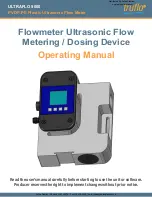
3
●
Do not subject the AC adapter to strong impact cause by striking it against a wall, dropping it, etc.
Otherwise, malfunction, damage, or electric shock might occur.
●
Should you sense any abnormality while inserting the scope into the object to be inspected,
do not try to force the operation and carefully withdraw the insertion tube. Note the following
precautions when withdrawing the insertion tube.
- Do not try to withdraw from the observation object while angulation is locked or while the
angulation section is bent.
- If the insertion tube becomes caught on something during withdrawal, rotate the control
unit gently while continuing the withdrawal.
●
Note the following precautions during handling the insertion tube's distal end.
- Do not drop the optical adapter or otherwise subject it to strong impact.
- Do not subject the distal end to severe impact or pulling.
- Do not expose the angulation section to severe impact or bending.
Otherwise, glass lenses and the precision components that make up the distal end and the
angulation section might be damaged.
●
Never use the instrument without an optical adapter mounted.
Otherwise, parts (screws, etc.) are easily subjected to deformation due to contact with hard
objects, etc. Deformed insertion tube parts can make it no longer possible to mount an opti-
cal adapter and can cause the optical adapter to fall off.
●
Never use an optical adapter when any of its parts are loose.
Otherwise, a loose part might fall into the inspection object.
●
The optical adapters have a safe double-screw installation design. However, if an optical
adapter starts to come off the distal end while inserting the scope into the object to be in-
spected, the entire or a part of the observed image may be whitish caused by the illumination
light or a part of the view field may be lacked. The optical adapter may fall off the insertion
tube's distal end if used in this condition. In this case, immediately stop the inspection, care-
fully withdraw the insertion tube and secure the optical adapter as described in"Attaching the
Tip adapter not
properly attached
(The strong light appears partially.)
The screen is viewed whitish.
The entire screen is
clearly viewed.
Correct
●
Should you sense any abnormality when performing angulation operation, do not try to force
the angulation operation.
Doing so can damage the insertion tube or observation object.
●
Never use the instrument while dirt or water is present in the optical adapter
Water tightness between the optical adapter and the distal end may be lost, or the optical
adapter or the distal end may be damaged.
●
If an optical adapter cannot be mounted or removed because the nut will not turn, stop using it.
Contact Olympus.
●
Do not look directly into the illumination being emitted by the distal end.
Otherwise, eye damage may result.
●
Take care not to have your feet caught by a cord including the power cord or universal cable.
●
When hanging the main unit from your neck by the shoulder strap, do not allow it to catch on
other objects. Be careful that it does not choke you.
●
Do not allow metal or other foreign objects to enter the main unit through connectors or any
other openings.
Otherwise, a malfunction or electric shock may result.
●
Do not use the parts other than the insertion tube in water or clean them under running water.
Water creates the risk of electric shock. The parts other than the insertion tube are designed for
water resistant proof construction only if the battery cover and connector caps are closed com-
pletely. Do not use or store the instrument under the environment where it is submerged or wet.










































